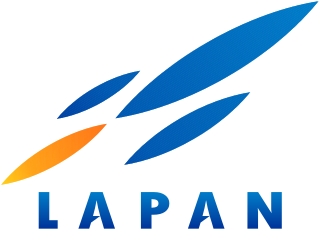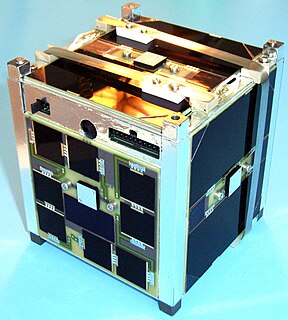
National Institute of Aeronautics and Space is the Indonesian government space agency. It was established on November 27, 1963, by former Indonesian president Sukarno after one year's existence of an informal space agency organization. LAPAN is responsible for long-term civilian and military aerospace research.
The Near Earth Object Surveillance Satellite (NEOSSat) is a Canadian microsatellite using a 15-cm aperture f/5.88 Maksutov telescope, with 3-axis stabilisation giving a pointing stability of ~2 arcseconds in a ~100 second exposure. It is funded by the Canadian Space Agency (CSA) and Defence Research and Development Canada (DRDC), and searches for interior-to-Earth-orbit (IEO) asteroids, at between 45 and 55 degree solar elongation and +40 to -40 degrees ecliptic latitude.
The Anna University Satellite, or ANUSAT was an Indian student research microsatellite designed, developed and integrated at Aerospace Engineering, Madras Institute of Technology (MIT), Chromepet, Anna University. Students and faculty members of Madras Institute of Technology and College of Engineering, Guindy were involved in the design of ANUSAT. The project director of the ANUSAT was Dr. P. Dhanraj, CASR, Madras Institute of Technology, Chromepet. It carries an amateur radio and technology demonstration experiments. It was successfully Integrated at the clean room facility at MIT, Chrompet, Chennai and launched aboard a PSLV-CA designated PSLV-C12, along with RISAT-2, from the Second Launch Pad at the Satish Dhawan Space Centre. The launch was carried out at 01:15 GMT on 20 April 2009.
ITUpSAT1, short for Istanbul Technical University picoSatellite-1) is a single CubeSat built by the Faculty of Aeronautics and Astronautics at the Istanbul Technical University. It was launched on 23 September 2009 atop a PSLV-C14 satellite launch vehicle from Satish Dhawan Space Centre, Sriharikota, Andhra Pradesh in India, and became the first Turkish university satellite to orbit the Earth. It was expected to have a minimum of six-month life term, but it is still functioning for over two years. It is a picosatellite with side lengths of 10 centimetres (3.9 in) and a mass of 0.990 kilograms (2.18 lb).

KITSAT-1 or KITSAT-A is the first satellite to be launched for the Republic of Korea. Once launched, the satellite was given the nickname "Our Star" (우리별).The KITSAT-1 is a low Earth orbit (LEO) satellite with a modular structure. Of the 12 LEOs launched by South Korea, KITSAT-1 has the highest altitude.While the KITSAT-1 maintains equilibrium by gravity gradient forces, magnetic torque can be used to control attitude if needed .The forecasted lifespan of the KITSAT-1 was only five years, but communication with the satellite was maintained for 12 years.Since the launch of the KITSAT-1, South Korea has launched an additional 36 satellites.

BeeSat-1 or Berlin Experimental and Educational Satellite 1, is a German satellite operated by the Technical University of Berlin. The spacecraft is a single unit CubeSat, which was designed to test systems intended for use on future spacecraft, including a new design of reaction wheel. It has also been used for amateur radio, and is equipped with a small camera.

The Amazônia-1 or SSR-1, is the first Earth observation satellite developed by Brazil, helped by Argentina's INVAP, who provided the main computer, attitude controls and sensors, and the training of Brazilian engineers, and launched at 04:54:00 UTC on 28 February 2021.
Sapphire is a Canadian space surveillance satellite which was launched in 2013. Sapphire was commissioned and integrated by MacDonald, Dettwiler and Associates (MDA) based on an SSTL-150 bus produced by Surrey Satellite Technology (SSTL) and an optical payload produced by COM DEV International.
IRS-1E was an Earth observation mission launched under the National Natural Resources Management System (NNRMS) programme by Indian Space Research Organisation (ISRO). Sometimes written IRS-P1. The objective of the mission was to develop Earth imagery using instruments carried on board. Due to a malfunction of the launch vehicle, the satellite deviated from its path and plunged into the Indian Ocean.
Oceansat-1 or IRS-P4 was the first Indian satellite built primarily for ocean applications. It was a part of the Indian Remote Sensing Programme satellite series. The satellite carried an Ocean Colour Monitor (OCM) and a Multi-frequency Scanning Microwave Radiometer (MSMR) for oceanographic studies. Oceansat-1 thus vastly augment the IRS satellite system of Indian Space Research Organisation (ISRO) comprising four satellites, IRS-1B, IRS-1C, IRS-P3 and IRS-1D and extend remote sensing applications to several newer areas.
Cartosat-2C is an Earth observation satellite in a Sun-synchronous orbit (SSO) and is a fifth flight unit of Cartosat series of satellites. The satellite is built at space application centre Ahemdabad, launched and maintained by the Indian Space Research Organisation (ISRO). It was launched on 22 June 2016.
PSLV-C28 was the 29th consecutive successful mission of the PSLV program. The PSLV-C28 carried and successfully deployed 5 satellites in the Sun-synchronous orbit. With a launch mass of 320,000 kilograms (710,000 lb) and payload mass of payload mass 1,440 kilograms (3,170 lb), the C28 was the heaviest commercial mission undertaken by the Indian Space Research Organisation and Antrix Corporation. The PSLV-C28 carried three identical optical earth observation satellites, an optical earth observation technology demonstrator microsatellite (CBNT-1), and an experimental nanosatellite (De-orbitSail). All the satellites were built by Surrey Satellite Technology (SSTL). Although built by SSTL, the "De-orbitSail" belonged to the Surrey Space Centre.
PSLV-C2 was the second operational launch and overall fifth mission of the PSLV program. This launch was also the forty-third launch by Indian Space Research Organisation since its first mission on 1 January 1962. The vehicle carried three satellites which were deployed in the Sun-synchronous low Earth orbit. The vehicle carried India's first remote sensing satellite Oceansat-1 (IRS-P4) as the main payload. It also carried South Korean satellite Kitsat-3 and German satellite DLR-Tubsat as auxiliary payloads. PSLV-C2 was the first Indian Expendable launch vehicle to carry and deploy more than one satellite in a mission. This was also India's and ISRO's first commercial spaceflight where South Korea and Germany each paid $1.0 million to ISRO for launching their satellites.
KITSAT-2 was a South Korean experimental Earth observation microsatellite. KITSAT-2 was South Korea's second satellite and was the first to be developed and manufactured domestically by the Korea Advanced Institute of Science (KAIST).
PSLV-C3 was the third operational launch and overall sixth mission of the PSLV program. This launch was also the forty-sixth launch by Indian Space Research Organisation since its first mission on 1 January 1962. The vehicle carried three satellites which were deployed in the Sun-synchronous Low Earth orbit. The vehicle carried Technology Experiment Satellite, BIRD and PROBA. This was India's and ISRO's second commercial spaceflight. PSLV-C3 was launched at 10:23 a.m. IST on 22 October 2001 from Satish Dhawan Space Centre.
PSLV-C4 was the fourth operational launch and overall seventh mission of the PSLV program. This launch was also the forty-eight launch by Indian Space Research Organisation since its first mission on 1 January 1962. The vehicle carried and injected India's first dedicated Meteorological satellite, Kalpana-1 into the Geosynchronous transfer orbit. PSLV-C4 was launched at 15:53 hours IST on 12 September 2002 from Satish Dhawan Space Centre.

PSLV-C6 was the sixth operational launch and overall ninth mission of the PSLV program. This launch was also the fifty-fourth launch by Indian Space Research Organisation since its first mission on 1 January 1962. The vehicle carried and injected India's two satellites; Cartosat-1 and HAMSAT into the Sun-synchronous orbit. PSLV-C6 was launched at 04:44 hours Coordinated Universal Time on 5 May 2005 from the second launch pad of the Satish Dhawan Space Centre.
TeLEOS-1 is Singapore's first commercial earth observation satellite launched on a PSLV-C29 vehicle of ISRO from SDSC at Sriharikota on 16 December 2015 along with other five satellites developed in Singapore. The satellite is aimed at providing high temporal imagery and geospatial solutions for homeland security and border control; maritime monitoring and disaster management around the equatorial belt. TeLEOS-1 is developed by ST Engineering.
The German space programme is the set of projects funded by the government of Germany for the exploration and utilisation of outer space. The space programme is run by the German Aerospace Center, who conduct research, plan, and implement the programme on behalf of the German federal government.




